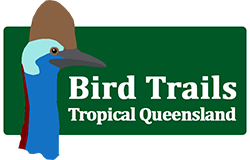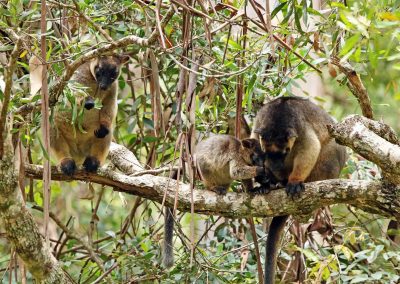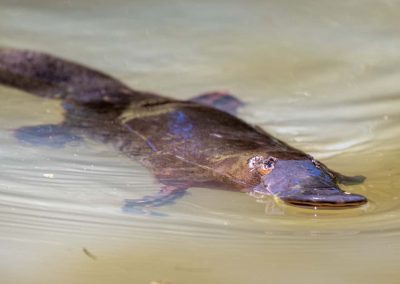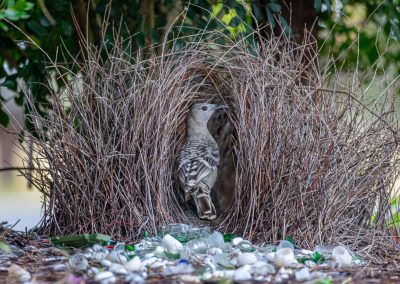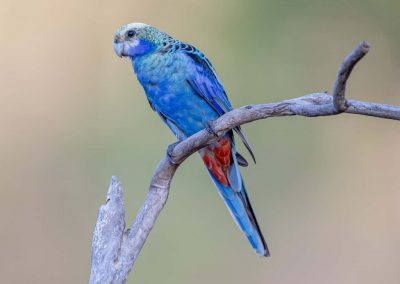Our Seasonal Changes
As is the case in most locations, there are seasonal fluctuations throughout the year in regard to the number and suite of birds present. In general, winter is a pleasant time to visit in regard to climate, and many of our iconic resident species are beginning to breed including Golden Bowerbird, Tooth-billed Bowerbird and Victoria’s Riflebird. From late winter through Spring these birds may be observed performing incredible courtship displays. Additionally through Spring there is a regular migration of a whole suite of bird species from New Guinea to spend the summer in Australia. This includes Pied Imperial Pigeon, Metallic Starling, Black Bittern, a multitude of cuckoos and the highly sought-after Buff-breasted Paradise-kingfisher. Additionally in Spring we see the arrival of a suite of shorebirds from the Northern Hemisphere. In Summer, many of the migrant species breed. Indeed many birdwatchers come here specifically in Summer to observe Paradise-kingfishers nesting in terrestrial termite mounds.
Most important, whatever time of year you decide to visit there will always be plenty of birds to see. Below is a guide to some of the important happenings during each of the seasons.
Winter (June, July, August)
- Golden Bowerbirds become active (usually in June) spending more time on or near bowers.
- Tooth-billed Bowerbirds become active (usually end of August) preparing ‘display courts’.
- Victoria’s Riflebirds become active (usually early July) spending more time around ‘display posts’.
- Brolga and Sarus arrive early June (sometimes May) to become common on the Atherton Tableland.
- Male Cassowaries are likely to be incubating eggs. Late winter, fathers re-appear with young stripey chicks in tow.
- Small mostly insectivorous birds (Monarchs, Fantails, Gerygones, Shrike-thrush amongst others) form loose, irregular feeding aggregations.
Read more...
- Individual members of typically higher elevation endemic birds (Victoria’s Riflebird, Fernwren, Bridled Honeyeater) can be found temporarily occurring at lower elevation.
- Blue-faced Parrot-finches move from high elevation to lower elevations to forage at mid-altitude locations.
- White-eared Monarchs are more vocal and hence more likely to be observed.
- Papuan Frogmouths are usually viewable on Daintree cruises.
- Little Kingfishers are at their most visible on Daintree cruises, particularly on low tides.
- Sacred Kingfishers become more common escaping cooler climes further south.
- Cattle Egrets, Black Kites & Whistling Kites numbers increase as cane harvest commences.
- Raptors, particularly Osprey, are likely to be nesting, often on telegraph poles along roadways.
- Topknot Pigeons migrate into the area to forage for fruit, particularly Blue Quandong.
- Owls are likely to be nesting.
Spring (September, October, November)
- A suite of shorebirds arrive from the Northern Hemisphere and become common.
- Buff-breasted Paradise-kingfishers arrive from New Guinea in late October or early November.
- Frogmouths, both Papuan and Tawny, nest in mid to late Spring, sometimes in Summer.
- About November, Little Kingfishers tend to depart low altitude areas for cooler higher altitudes.
- Black Bitterns become common on Daintree cruises in mid to late Spring.
- Pied Imperial-pigeons arrive from New Guinea and become common in coastal areas.
Read more...
- Metallic Starlings arrive from New Guinea and become common in coastal areas.
- A suite of cuckoos (Channel-billed, Brush, Koel etc) arrive from New Guinea and beyond to breed in Australia.
- Late in this period, Oriental Cuckoos arrive as a non-breeding summer visitor.
- Dollarbirds arrive and remain present for the Summer.
- Black-faced Monarchs and Satin Flycatchers may be observed on southern migration.
- About October, large numbers of Spangled Drongos can be observed along the coast on southern migration.
- Brolga and Sarus may be observed ‘dancing’, courting, reinforcing pair bonds.
- In late Spring, Brolga and Sarus mostly depart the Atherton Tablelands for breeding grounds elsewhere.
- The display season of Victoria’s Riflebirds finishes about November.
- Cattle Egrets develop an orange breeding hue before the commencement of the Summer breeding season.
- Blue-faced Parrot-finches move to higher altitudes, becoming reliable at sites like Mt. Lewis about November.
- Grass Owls are at their most visible on the Atherton Tablelands due to the harvest of hay and maize.
- White-throated Needletails and Pacific Swifts are at their most numerous in late Spring and Summer.
- Duck numbers are likely to be at their greatest at ponds like Hastie Swamp due to lack of water elsewhere.
- Red-tailed Black-cockatoo numbers are at a peak in the areas around Mareeba and Atherton.
- Noisy Pittas become vocal and more visible in late Spring.
- Australian Bustard are likely to performing conspicuous courtship displays from late Spring through Summer.
Summer (December, January, February)
- A suite of shorebirds are present; busy feeding, gaining weight.
- Buff-breasted Paradise-kingfishers are nesting, usually bringing feed to young in February.
- Black Bitterns are nesting and should be visible on Daintree River cruises.
- Pied Imperial-pigeons are nesting in large numbers on offshore islands and along coast including Cairns Esplanade.
- Metallic Starlings are nesting in large communal nesting trees.
- Sacred Kingfishers become less common returning to southern parts of Australia.
Read more...
- Further afield, Papuan Pittas and Black-winged Monarchs arrive from PNG to northern Cape York in Dec or January.
- Further afield, Palm Cockatoos and Eclectus Parrots are likely to be nesting.
- Crakes become more vocal and visible.
- Golden Bowerbird display season finishes about December.
- Tooth-billed Bowerbird display season finishes about December.
- Victoria’s Riflebirds are in moult in January & February and are more difficult to find.
- The number of Cattle Egrets is reduced.
Autumn (March, April, May)
- A suite of shorebirds depart, returning to the Northern Hemisphere.
- Adult Buff-breasted Paradise-kingfishers depart for New Guinea usually about the end of March.
- Juvenile Buff-breasted Paradise-kingfishers depart for New Guinea usually in April.
- A suite of cuckoos depart for New Guinea and beyond.
- Most Pied Imperial-pigeons and Metallic Starlings depart for New Guinea.
- Owls are most likely to be heard calling in late Autumn.
